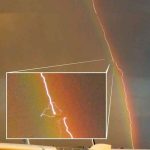Key Takeaways:
- The phenomenon of halos around the sun or moon, known as 22-degree halos, is caused by high cirrus clouds containing ice crystals.
- These halos result from both light refraction and reflection within these ice crystals, creating a ring of light around the sun or moon.
- Halos are unique to each observer due to the specific orientation of ice crystals, differentiating them from others’ halos.
- Photographing solar halos requires caution as direct exposure to the sun’s rays can be damaging.
- Lunar halos, often considered a sign of rain, are caused by cirrus clouds preceding storms, while halo types and frequencies can vary across different regions and weather conditions.
Have you ever cast your eyes skyward only to find an enigmatic luminous ring encircling the sun or moon? Referred to as 22-degree halos, these captivating celestial halos captivate observers with their mystical allure. Contrary to their intriguing appearance, their formation lies in the physics of high cirrus clouds, which often prelude storms. Characterized by a radius of approximately 22 degrees, these halos are produced by minuscule ice crystals within the clouds, refracting and reflecting light to create a radiant circle. Remarkably, the position and orientation of these ice crystals determine the halo’s appearance, rendering each observer’s experience uniquely personal.
While halos have been linked to weather folklore, they serve as scientific indicators. These halos signify the presence of high, thin cirrus clouds situated at altitudes of over 20,000 feet. However, photographing solar halos necessitates caution to protect the camera and the eyes from the sun’s intense rays. Additionally, discussions have arisen about the prevalence of halos at varying latitudes. While some forms of halos occur exclusively in polar regions, others can manifest globally depending on factors like cirrus cloud coverage and the presence of halo-inducing ice crystals. These atmospheric wonders not only inspire wonder but also offer insights into the intricate workings of Earth’s atmosphere.
The captivating phenomenon of halos is a product of nature’s artistry, revealing its beauty in a ring of light encircling the moon or sun. Enigmatic and spellbinding, 22-degree halos have intrigued sky gazers for centuries. Although these halos might appear as ethereal manifestations, their origin lies in the interaction of light with ice crystals within high cirrus clouds, creating an optical spectacle that leaves observers in awe. Distinct from one another due to the unique orientation of ice crystals, these halos are as individual as the onlookers themselves.
When these halos grace the moon’s presence, they often appear colorless due to the dimness of moonlight. However, when around the sun, their hues become more pronounced, with red on the inner edge and blue on the outer edge. Despite their captivating beauty, halo observations offer more than meets the eye. The inner edge of the halo presents a sharp demarcation, while the outer edge is diffused. Additionally, the surrounding sky takes on a darker hue than its surroundings, amplifying the halo’s ethereal splendor.
The exploration of celestial halos transcends terrestrial boundaries, extending into the cosmic expanse. Recent revelations from the Hubble Space Telescope have illuminated the profound complexities of galactic halos, with the Andromeda galaxy taking center stage. The telescope’s ultraviolet gaze was turned toward Andromeda, offering an unprecedented view of its halo. Through the analysis of quasar light, Hubble mapped the presence of gaseous elements within Andromeda’s halo, revealing a dynamic structure beyond expectations.
Andromeda’s halo spans a staggering 1.3 million light-years from the galaxy, far more expansive than anticipated. Its intricate layers, marked by distinct inner and outer shells, reveal the lasting impact of stellar explosions and the dispersal of heavy elements. As the Milky Way and Andromeda galaxies edge closer to a future collision, the study of Andromeda’s halo provides a unique opportunity to understand the intricate galactic forces shaping our cosmic neighborhood.
#1

Teresa Molinaro in Palermo, Italy, captured this halo image on May 17, 2023 and wrote, “Sun halo in the blossoms tree.”
#2

Supriya Chakrabarty of Kolkata, West Bengal, India, captured this halo around the sun on March 21, 2023, and wrote: “22 Degree Solar Halo from Kolkata India.
#3

Sheryl R Garrison captured this image on January 3, 2023, in Southern Alberta, Canada, and wrote: “I love reading EarthSky’s newsletter in the morning. It reminds me of what to look for in the night sky. When I went outside after dark, not only did I see Mars near the moon but there was an added bonus of a lunar 22-degree halo.”
#4

Everyone sees his or her own halo. That’s because – for every individual – a solar or lunar halo is made of light reflecting and refracting from different ice crystals in high, thin cirrus clouds. Image via Vincenzo Mirabella in Italy/ NASA
#5

Meiying Lee in Taipei, Taiwan, took this image of the planets on June 21, 2022
#6

Anubha Singh in Hyderabad, India, caught this beautiful 22-degree halo around the sun on June 2, 2021.
#7

Soumyadeep Mukherjee in Kolkata, West Bengal, India, captured this photo of a lunar halo on September 25, 2021
#8

Jayesh Jayesh J of Vadodara, Gujarat, India caught this beautiful 22-degree halo around the sun on August 29, 2020
#9

An artist’s depiction showing what the Andromeda Galaxy halo would look like in the sky if our eyes could see it. (Image credit: NASA, ESA, J. DePasquale and E. Wheatley (STScI), and Z. Levay)
#10

A diagram showing the quasars used to map the halo of the Andromeda galaxy. (Image credit: NASA, ESA, and E. Wheatley (STScI))


